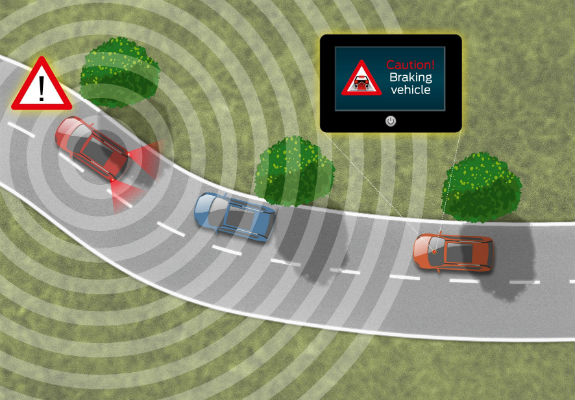News Center
News CenterFord Tests High-Tech “Brake Light” That Communicates With Car Behind

- Ford tests early warning car-to-car communication feature that alerts drivers to vehicles braking ahead – even around corners and through traffic
- Experimental technology called “Electronic Brake Light” transmits a wireless signal to illuminate a dashboard light on following vehicles
- The technology is among 20 systems Ford tested for Safe Intelligent Mobility – Testfield Germany (simTD); the joint industry research project finds intelligent transport systems could reduce congestion and potentially improve safety
- Specially-equipped Ford S-MAX models were used to test the technologies for simTD; Ford also tested Obstacle Warning, which alerts drivers to objects on the road, and Traffic Sign Assistant, which provides up-to-date information from traffic management centres
AACHEN, Germany, June 21, 2013 – Ford has participated in a special test of a high-tech early warning “brake light” that can warn drivers following behind even if they are around a bend or behind other traffic.
The technology is one of 20 potential future systems Ford tested as part of Safe Intelligent Mobility – Testfield Germany (simTD), a four-year joint industry research project.
In emergency braking situations, the experimental “Electronic Brake Light” transmits a wireless signal to illuminate a dashboard light in cars following behind. The study found the technology could enable drivers to brake earlier and potentially mitigate or avoid a collision.
The simTD field tests involved 500 test drivers in 120 vehicles – including 20 Ford S-MAX models. Testers logged more than 41,000 hours and almost a million miles on public roads and an enclosed test track in Germany.
“Car-to-car and car-to-infrastructure communications represent one of the next major advancements in vehicle safety,” said Paul Mascarenas, Ford’s chief technical officer and vice president, Ford Research and Innovation. “Ford is committed to further real-world testing here and around the world with the goal of implementation in the foreseeable future.”
Ford used specially-equipped Ford S-MAX models to help test the potential of car-to-car and car-to-infrastructure communication; also testing Obstacle Warning system, which alerts to the presence, position and type of potentially hazardous objects in the road, and Traffic Sign Assistant, that keeps in contact with traffic management centres for up-to-date information.
Engineers from Ford’s European Research Centre in Aachen, Germany, led the Electronic Brake Light development, testing and data analysis.
Further technologies tested for simTD included:
- Public Traffic Management, which provides exact traffic prognosis based on comprehensive information; this includes identifying likely traffic scenarios and their impact at the point in the journey when they are encountered rather than at the point of departure
- In-car Internet Access, which, for example enables the driver to receive information about free parking spaces or check traffic hotspots by receiving up-to-date pictures from traffic cameras.
As a global leader in researching car-to-car and car-to-infrastructure communications, Ford is engaged in the European Commission-supported field operational tests DRIVE C2X, and in the U.S. contributing to Safety Pilot Model Deployment, a field test of more than 2,800 vehicles in cooperation with the University of Michigan in Ann Arbor.
Collating results from these programmes supports Ford’s objective of harmonising standards for messaging and hardware globally that would enable the delivery of new technologies faster, more efficiently, and more economically.
simTD is a joint project by leading German automotive manufacturers, component suppliers, communication companies, research institutions and public authorities. The funding for the project was approximately £45million, of which £26million of direct project promotional support was provided by the Federal Ministry of Economics and Technology (BMWi) together with the Federal Ministry of Education and Research (BMBF).
Further information on simTD can be found at www.simTD.de.
# # #
About Ford Motor Company
Ford Motor Company, a global automotive industry leader based in Dearborn, Mich., manufactures or distributes automobiles across six continents. With about 175,000 employees and 65 plants worldwide, the company’s automotive brands include Ford and Lincoln. The company provides financial services through Ford Motor Credit Company. For more information regarding Ford’s products, please visit www.ford.com
Ford of Europe is responsible for producing, selling and servicing Ford brand vehicles in 50 individual markets and employs approximately 47,000 employees at its wholly owned facilities and approximately 69,000 people when joint ventures and unconsolidated businesses are included. In addition to Ford Motor Credit Company, Ford Europe operations include Ford Customer Service Division and 24 manufacturing facilities (15 wholly owned or consolidated joint venture facilities and nine unconsolidated joint venture facilities). The first Ford cars were shipped to Europe in 1903 – the same year Ford Motor Company was founded. European production started in 1911.
Related
-
Ford Returned to 2013 ESSENCE Festival in New Orleans for Fifth Consecutive Year as Exclusive Automotive Sponsor
-
Ford Motor Company Sponsors Usher's New Look for Fourth Consecutive Year
-
Ford Develops Advanced Technology to Revolutionize Prototyping, Personalization, Low-Volume Production
-
One Millionth Ford Vehicle Sold in Russia, a Ford Focus; Signals Strength of Global Lineup and Profitable Growth








Connect With Ford
Ford Motor Company on Facebook
Ford Motor Company on YouTube
Follow @Ford on Twitter
Ford Motor Company on Flickr